

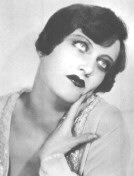
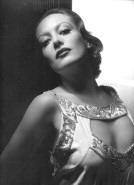




The Best of A
 Above
Suspicion. MGM, 1943. Directed by Richard Thorpe, 91 minutes. Joan stars with
Fred MacMurray
as newlywed "Frances Myles," drafted by the British Secret Service
to spy on the Nazis. This was
Joan's last MGM contract picture.
Says Joan in CWJC: No
prize this one...but I must say that both Fred MacMurray and I tried to make
the spy nonsense plausible. I really wasn't suited to the wartime melodramas
they were turning out, and if a script was bad I was worse.
Above
Suspicion. MGM, 1943. Directed by Richard Thorpe, 91 minutes. Joan stars with
Fred MacMurray
as newlywed "Frances Myles," drafted by the British Secret Service
to spy on the Nazis. This was
Joan's last MGM contract picture.
Says Joan in CWJC: No
prize this one...but I must say that both Fred MacMurray and I tried to make
the spy nonsense plausible. I really wasn't suited to the wartime melodramas
they were turning out, and if a script was bad I was worse.
The Hays Office found a few things in the picture objectionable: the killing of a Nazi that goes unpunished; as well as the lines "What are you doing tonight?" (deemed to suggest "sexual frustration on the part of Miss Crawford") and "Think of what we're going to do"..."I am." (US)
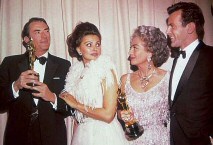 Academy
Awards. (See
also The
Oscar.) Joan won an Oscar for Best Actress (Mildred Pierce)
in 1946, and was nominated for two other Best Actress awards,
for Possessed ('47) and Sudden Fear ('52). She also had a role at the awards
show on 4 occasions:
Academy
Awards. (See
also The
Oscar.) Joan won an Oscar for Best Actress (Mildred Pierce)
in 1946, and was nominated for two other Best Actress awards,
for Possessed ('47) and Sudden Fear ('52). She also had a role at the awards
show on 4 occasions:
(1) On 3/19/53, the 25th anniversary of the Oscar, Joan (nominated that year for "Fear") appeared onstage at the end of the show with her statuette as part of a tribute to past nominees.
(2) On 4/9/62, Joan presented the Best Actor award to Maximilian Schell for Judgement at Nuremberg. (See also the Rita Moreno entry for Moreno's encounter with Joan that night after winning her West Side Story Oscar.)
(3) On 4/8/63, Joan presented the Best Director award to David Lean for Lawrence of Arabia, and accepted the Best Actress award on behalf of Anne Bancroft for Miracle Worker (thus satisfactorily upstaging Bette Davis, nominated for "Baby Jane" that year).
(4) On 4/15/65, Joan presented the Best Director award to George Cukor for My Fair Lady.
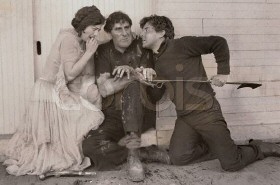 Across
to Singapore. MGM silent, 1928. Directed by William
Nigh, 78 minutes.
Joan's only film with silent star Ramon Novarro. Joan plays neighbor's daughter "Priscilla Crowninshield,"
who's been in love with Novarro's seafaring character since childhood and who
is also coveted by Novarro's tough brother, played by Ernest Torrence. Said
Joan: I didn't like the Singapore picture
at all--both Ramon Novarro and I were terribly miscast.
(CWJC)
Across
to Singapore. MGM silent, 1928. Directed by William
Nigh, 78 minutes.
Joan's only film with silent star Ramon Novarro. Joan plays neighbor's daughter "Priscilla Crowninshield,"
who's been in love with Novarro's seafaring character since childhood and who
is also coveted by Novarro's tough brother, played by Ernest Torrence. Said
Joan: I didn't like the Singapore picture
at all--both Ramon Novarro and I were terribly miscast.
(CWJC)
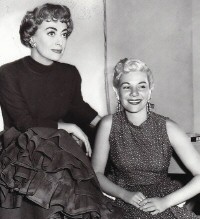 Adams,
India (3/5/1927 - 4/25/2020).
Adams,
India (3/5/1927 - 4/25/2020).
Adams does the actual singing for Joan's character "Jenny Stewart" in the 1953 MGM film Torch Song. Songs include "You Won't Forget Me," "Tenderly," and "Two-Faced Woman." (Cheapo MGM: The latter is an outtake from the '53 musical film The Band Wagon that Adams had already dubbed for Cyd Charisse. The "Band Wagon" soundtrack, with Adams' songs, is currently available from amazon.com.)
From the 2008 David Del Valle interview with Adams re working with Joan in Torch Song:
India Adams had nothing but praise for Joan Crawford as a professional and Hollywood star of the first rank. These two women bonded during the making of TORCH SONG and India has the letters from Crawford to back it up. ... The two women remained friends throughout the filming and afterwards as well. If Joan liked you she did her very best to be of help and make suggestions regarding your career, India told me. They were still in touch when MGM asked India to make a record for the studio, and then made a strange request. MGM asked me not to mention a word about this album to Joan Crawford until it was in release. I thought nothing of it at time, and did as they requested. When the record came out, the fact I kept it from Joan hurt her feelings to the point that it ended my relationship with her.
Wikipedia page Personal website
Addams Family, The. Jackie Coogan, Jr., the child star of Joan's 1925 silent film Old Clothes, went on to appear as "Uncle Fester" in this 30-minute ABC show that ran from 1964 - 1966. Click here for more info on the show.
Addresses of Joan. Given here chronologically. (Pre-Hollywood info from JB and JCB; when accounts of some dates/exact addresses vary, I've listed both.) See the Geography page for photos of Joan's homes and schools.
PRE-HOLLYWOOD:
1905
or 1906. San
Antonio: born and lived briefly on South Cherry Street while mother Anna
was still married to Thomas LeSeuer. Map of S Cherry St
1910 - 1916. Lawton, Oklahoma: JB says Joan, mother, brother, and stepfather Henry Cassin lived at 804 D Avenue. The 1910 Comanche County census says that the family lived at 910 D Avenue that year at least.
1916
- Summer 1922. Kansas
City, Missouri:
New Midland
Hotel. 400-block of E. 9th St. (JB says it was across the street from the
City Gate Laundry, cited below.)
403 East 9th St. Site
of the City Gate Laundry, where Joan and her mother and brother worked and
lived.
4407
Genessee Street (mother and lover Harry Hough's home)
3426
or 3430 Wyandotte, at Armour (mother and brother's apartment after separation from
Hough)
While
in Kansas City, Joan only briefly lived at the New Midland Hotel, then was sent
to these boarding schools:
St.
Agnes Academy (128 N. Hardesty, at Scarritt)
Rockingham
Academy (4343 Campbell)
Fall 1922. Columbia, Missouri: Joan lived at Main Hall at Stephens College for one semester. (1200 E. Broadway is the current school address; no info on whether it changed locations, though Main Hall has since been torn down.)
Early 1923 - March 1924: After leaving college, Joan worked briefly in Kansas City, then got a chorus job in Springfield, Missouri (with Katherine Emerine's show); travelled to Chicago, Oklahoma City, and Detroit (with Ernie Young's shows).
March 1924 - Christmas 1924: New York City, appearing in J.J. Shubert's "Innocent Eyes" and "The Passing Show of 1924" and at Harry Richman's nightclub. Home to Kansas City for Christmas, then received telegram calling her to Los Angeles.
LOS ANGELES:
January 1925 - ?: Hotel Washington
1927 - September 1928: 513 N. Roxbury Drive, Beverly Hills
September 1928 - 1955: 426 N. Bristol Avenue, Brentwood
POST-HOLLYWOOD (NEW YORK CITY & LOS ANGELES):
1955 - 1957: After marrying Al Steele in May '55, the couple stayed primarily in his apartment at 36 Sutton Place while their new apartment was being renovated. (The Bristol Ave. home in Brentwood was finally sold in 1957 to Donald O'Connor.)
1957 - 1967: Duplex at 2 East 70th Street, at Fifth Avenue.
Post 1959 - early 1970s: After husband Steele's death in 1959, Joan began to keep a small apartment in Los Angeles for use during her frequent trips there. Located at 8313 Fountain Avenue, Apt. D, the 2-bedroom, 2-floor condo was in a building owned by actress Loretta Young. Joan paid approximately $400 per month in rent.
1967 - until her May '77 death: Imperial House: 150 East 69th Street (between Lexington Ave. and 3rd Ave.) In 1973 she moved from a 9-room apartment (22G) to a 5-room apt. (22H).
Other addresses: Christina Crawford says that Joan kept a New York City apartment at East End Avenue in the early 1940s. (Letters from Joan in 1945 and 1946 have a 130 East End Ave. return address.) In the winter of '46-47, Joan rented a house in Bedford Village, where Christina and Christopher stayed while Joan lived in the city. Also, after husband Steele died in '59, Joan began using her secretary Betty Barker's office address, 8008 West Norton, Los Angeles, as a return mailing address.
AD-orama. Pepsi advertising campaign devised by Joan's husband Al Steele to convince national bottlers of Pepsi's superiority to Coke. He barnstormed the country for 8 weeks in early 1959 in support of it, which drained him of his health. He died that May. (JCB)
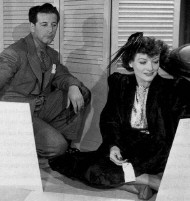 Adrian,
Gilbert. (3/3/03 - 9/14/59)
Adrian (born "Adrian Adolph Greenburg") initially went to Hollywood as a freelance
designer for Mae Murray and Rudolph Valentino, among others. He was
then hired by Cecil B. DeMille, moving along with DeMille to the MGM studio
in 1928, where he was soon designing costumes
for the studio's leading actresses. (He stayed with MGM until 1941.) He began designing for Joan in 1929, discarding her earlier frilly
flapper styles for a more sleek, tailored look. His padded-shouldered creations
for her '32 film Letty Lynton became a nationwide sensation; costume
designer Edith Head later called "Lynton" the "single most important
influence on fashion in film history." Adrian designed all of Joan's onscreen
clothes, and some of her personal wardrobe, throughout her MGM years. (JCB,
IMDb) More
Adrian info.
Adrian,
Gilbert. (3/3/03 - 9/14/59)
Adrian (born "Adrian Adolph Greenburg") initially went to Hollywood as a freelance
designer for Mae Murray and Rudolph Valentino, among others. He was
then hired by Cecil B. DeMille, moving along with DeMille to the MGM studio
in 1928, where he was soon designing costumes
for the studio's leading actresses. (He stayed with MGM until 1941.) He began designing for Joan in 1929, discarding her earlier frilly
flapper styles for a more sleek, tailored look. His padded-shouldered creations
for her '32 film Letty Lynton became a nationwide sensation; costume
designer Edith Head later called "Lynton" the "single most important
influence on fashion in film history." Adrian designed all of Joan's onscreen
clothes, and some of her personal wardrobe, throughout her MGM years. (JCB,
IMDb) More
Adrian info.
Growing old is no fun, especially for a woman...Maybe I don't have all the inner resources I need to grow old gracefully...but I wonder how many senior citizens, whether they're ex-movie stars or simply rich or actually down-and-out, welcome growing old. Frankly, if they say they enjoy it, I think they're either lying through their teeth or they've gone senile. Then there's that "You're only as old as you feel" business, which is true to a point, but you can't be Shirley Temple on the Good Ship Lollipop forever. Sooner or later, dammit, you're old.
I actually realized the awful difference age could make at a big Pepsi sales meeting...I was waiting for an elevator and I actually heard a woman beside me say to another, "See her? She used to be Joan Crawford." I couldn't burst into tears because I was to speak in ten minutes and it had taken me two hours that morning to put on the makeup that made me look like Joan Crawford...I hadn't even felt old when I heard about how much trouble there was getting money to produce Baby Jane because nobody wanted to finance "those two old broads." But at that moment I suddenly felt old, and I've felt old ever since.
...If "old" is the way you feel, baby, I'm 200 going on 300...Dietrich thinks she's a reincarnation of Mistinguette, and her legs are great, but I wonder how much work goes into removing the wrinkles that have to come...and Garbo, in spite of all the work she's had done in Switzerland and Romania and those health diets, looks old. But goddammit, the image is created, and it's up to you to keep fitting the image. If you try too hard--and I did it for several years--you look like a plastic caricature of yourself. Naturally, you do everything you can to shed years from your appearance. You try not to drink too much, and you diet like mad, and exercise, and get the right amount of sleep, and you exercise again, and you keep your sex life active, and it's one hell of a regimentation.
If you're lucky you come up with parts that let you play an older woman, but by the time I'd reached "that certain age" all the good parts were written for men. If your whole life has been acting and all of a sudden there's no place to go to act you're like a warhorse that's been put out to pasture. Something in you dies...when your whole life has been acting, and nobody wants you to act anymore -- it's like trying to exist in a vacuum. I won't say "live" in a vacuum; the word "exist" is a lot more appropriate...
The older woman, especially if she's single or a widow, is a social liability. There aren't as many older single men or widowers, so they're always in demand, and they can have a ball if they want to--hostesses are always crying for an extra man...Life is a lot like Noah's Ark. Everything goes in twosomes, so it doesn't matter if you're an ex-actress or Annie Nobody: As a single you're a drag. You can impose yourself upon your children or your close friends only so much of the time--the bulk of it you have to hack by yourself, and there are only so many books you want to read or TV shows you want to watch or records you want to listen to or memories you want to revive. Sometimes the walls close in on you.
No, growing old isn't fun, no matter what the Pollyanas say. I liked my elastic body and a mind that worked just a little bit faster than it does now. I don't dig the geriatric scene.
Age of Innocence, The. Joan's second husband Franchot Tone made his Broadway debut in this play, which starred Katharine Cornell. The play ran for 207 performances from 1928 to 1929.
 Aherne,
Brian. (5/2/02 - 2/10/86) British actor, Joan's co-star in
Aherne,
Brian. (5/2/02 - 2/10/86) British actor, Joan's co-star in
1935's
I
Live My Life (both the film
and radio versions) and 1959's The
Best of Everything. IMDb
info.
Airport '77. Joan was initially offered the part of "Emily Livingston" in this all-star-cast disaster picture about a 747 loaded with VIPs that is hijacked and then crashes in the Bermuda Triangle. Said Joan in LW: "I wanted Joel McCrea to play opposite me, and anyway, they actually asked me to fly out there with only one week's notice! Why, that is hardly enough time for makeup tests or rehearsals...and when I asked about costume fittings, they said they wanted me to wear my own clothes!" The film ultimately featured Jack Lemmon, James Stewart, Joseph Cotten (in the would-be McCrea role), Lee Grant, and Olivia de Havilland in the Livingston role.
Albert, Katherine. An MGM press agent when Joan arrived at the studio in 1925, she and Joan soon became close friends, remaining so after Albert married fellow writer Dale Eunson and left MGM to freelance. (Among other scoops, Joan gave Albert the exclusive for "Modern Screen" that she and Doug Jr. were divorcing.) In 1934, Albert and Eunson had a daughter, Joan, for whom Crawford was the godmother. In 1952, the friendship came to an end when Albert asked Joan to talk some sense into her daughter, who was about to marry at the young age of 18. Joan invited the young couple to her house, then phoned Albert that night that her daughter had just been married in her home. Albert never spoke to Joan again. (JCB)
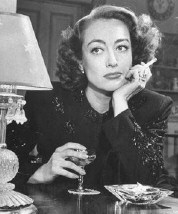 Alcoholism
of Joan. Says Joan in CWJC:
Alcoholism
of Joan. Says Joan in CWJC:
Yes, I have a drinking problem...I like to think it started after Alfred's death [1959], but I'm afraid it began well before that, when I used to fortify myself before a [Pepsi] sales meetings or one of the luncheons or dinners we either gave or attended. (I'm not a public person at all, and my God, I just remembered something--I used to have a few before I had to meet the press, 'way back at Metro. But when does a problem get to be a problem?)
When I was young I handled liquor well. We all drank--it was part of going to a club, parties at home, lunches off the set--the film community drinks its share. Probably more than its share. But the only times I ever got drunk were on those special, dangerous occasions, like champagne in the afternoon, or a really gala evening.
I think the problem began when I had to jack myself up to meet people...Vodka relaxed me, chased away the butterflies, put a certain safe distance between me and everybody else. I had some protection...but I'm afraid I crossed over the line when Baby Jane was being shot. Then the drinking worked its way into the production schedule. (That was such a bitch. How the hell could anyone cope with Davis and Altman dead sober?)
After Alfred died, and I was really alone, the vodka controlled me. It dulled the morning, the afternoon, and the night, and I wanted all of them dulled. But about a year-and-a-half ago I was on the phone one night with one of the twins, Cathy, I think, and I suddenly realized I didn't know why I'd called or what we talked about and what she was saying and that did it. That kind of drinking went. When I drink now it's on special occasions.
I really think alcoholism is one of the occupational hazards of being an actor, of being a widow, and of being alone. I'm all three...but when I realized the mess I'd gotten myself into I was strong enough to quit... I just didn't want to turn into a blowsy old relic. I couldn't see myself walking into an AA meeting and getting up and saying, "Hello, I'm Joan and I'm an alcoholic."
But to be perfectly honest I'd have to admit that the drinking problem began in my middle years in Hollywood [1938, 1939, 1940]--that was when the whole damned industry seemed absolutely determined to create new highs and new lows. The trauma--God!
According to The Last Years, Joan quit the bottle for good in late 1974.
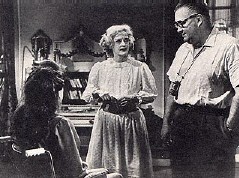 Aldrich,
Robert. (8/9/18 - 12/5/83) Director of Joan's 1956 film Autumn Leaves and 1962's
What Ever Happened to Baby Jane. He later directed Hush,
Hush, Sweet Charlotte (which Joan dropped out of) and is also best
known
for his films Kiss Me Deadly ('55), The Dirty Dozen
('67), and The Killing of Sister George ('68). Rumored to have been a one-time
Joan paramour, she later in her 1973 Town Hall appearance excoriated him, saying
that he had "many, many insecurities" and loved "evil things,
vile things." (!) (JCB)
Aldrich,
Robert. (8/9/18 - 12/5/83) Director of Joan's 1956 film Autumn Leaves and 1962's
What Ever Happened to Baby Jane. He later directed Hush,
Hush, Sweet Charlotte (which Joan dropped out of) and is also best
known
for his films Kiss Me Deadly ('55), The Dirty Dozen
('67), and The Killing of Sister George ('68). Rumored to have been a one-time
Joan paramour, she later in her 1973 Town Hall appearance excoriated him, saying
that he had "many, many insecurities" and loved "evil things,
vile things." (!) (JCB)
A-List,The. After her 1932 divorce from first husband Doug Fairbanks, Jr., Joan was off the Hollywood A-list and later said this in CWJC about the whole party circuit:
It was expensive, and [the parties] were so goddam "arranged" that nobody relaxed until late in the evening, when they could crawl into their own cliques and let their hair down. There were photographers, and reporters (they usually cleared out early) and you made sure that the seating arrangements were very, very proper. While I was married to Doug we gave and went to the biggest and best parties in town. After our divorce he was still invited, but Joan wasn't...Even while I was married to Franchot, who was one of the most sophisticated and cultivated and charming men you could meet, I never really made it back to that so-called A-list. For a while it hurt, but then I began inviting people I really wanted to invite when I threw a bash and went to the parties where I was really wanted.
It was all absurd. I remember looking at the ruins after a really big dinner party Doug and I had given...and I counted 45 uneaten filet mignon and at least 30 uneaten shrimp cocktails, and enough fruit compote to supply the MGM commissary for a week, and I almost cried at the waste. A director had thrown up in one of the downstairs bathrooms, and a starlet had passed out in one of the bedrooms, and another starlet had obviously entertained several gentlemen in another bedroom, and when I discovered all this I really did cry, because as far as I know nobody had a good time...
A few months after we were married Franchot and I gave an elegant dinner party for 40, and I remember...discovering that 24 of the 40 were people the studio or our agents had recommended, people we wouldn't have invited to a dogfight. Worse memory: Just after the Commie business hit the industry...I had to un-invite, at studio command, two actresses, and actor, and two writers, who'd been invited to a party I couldn't cancel...
All Souls Unitarian Church. See Memorial Service.
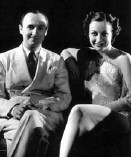 Altman,
Al. MGM's New York City talent scout from 1924 'til the
early '60s. Discovered Joan (Lucille LeSueur) on the New York
stage and directed her initial December 1924 screen tests at the
(now-demolished) Fox Studio on 10th Avenue and 54th St.
Altman,
Al. MGM's New York City talent scout from 1924 'til the
early '60s. Discovered Joan (Lucille LeSueur) on the New York
stage and directed her initial December 1924 screen tests at the
(now-demolished) Fox Studio on 10th Avenue and 54th St.
Altman Cleaners. Joan's clothes service in New York.
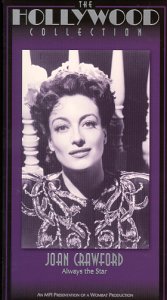
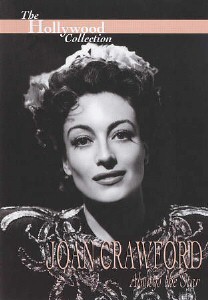 Always the Star.
53-minute Joan documentary, available on VHS (2000) and DVD (2009), that originally aired
in 1996 on cable's
A&E channel as part of its
"Biography" series. Directed and written by Gene Feldman and Suzette
Winter. It can currently be viewed for free on YouTube and for a
fee on Amazon Prime.
Always the Star.
53-minute Joan documentary, available on VHS (2000) and DVD (2009), that originally aired
in 1996 on cable's
A&E channel as part of its
"Biography" series. Directed and written by Gene Feldman and Suzette
Winter. It can currently be viewed for free on YouTube and for a
fee on Amazon Prime.
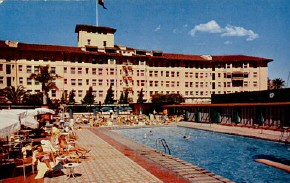 Ambassador
Hotel. Los Angeles landmark located at 3400 Wilshire Blvd. It
opened on New Year's Day 1921 and soon became the stomping grounds for Hollywood's
elite. Its club, the Cocoanut
Grove, was the site where Joan won over 100 dance trophies in her
early years in Hollywood. The hotel hosted 6 academy awards ceremonies and was
the site of the first Golden Globes awards. In 1968, the Ambassador became
infamous as the site of Robert F. Kennedy's assassination. The hotel closed
in 1989 and in 2005-2006 was razed to build a K-12 school on the 23-acre grounds. (Only
the hotel entrance and the east wall of the Cocoanut Grove remain.) Info/photos.
Ambassador
Hotel. Los Angeles landmark located at 3400 Wilshire Blvd. It
opened on New Year's Day 1921 and soon became the stomping grounds for Hollywood's
elite. Its club, the Cocoanut
Grove, was the site where Joan won over 100 dance trophies in her
early years in Hollywood. The hotel hosted 6 academy awards ceremonies and was
the site of the first Golden Globes awards. In 1968, the Ambassador became
infamous as the site of Robert F. Kennedy's assassination. The hotel closed
in 1989 and in 2005-2006 was razed to build a K-12 school on the 23-acre grounds. (Only
the hotel entrance and the east wall of the Cocoanut Grove remain.) Info/photos.
See this "Ambassador's Last Stand" blog for photos of the Ambassador before and after renovation.
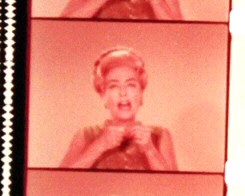 American
Cancer Society. In 1967, Joan
appeared on the ACS "Crusade '67" telethon, reciting Edna
St. Vincent Millay's "Dirge without Music." In 1973, Joan appeared in both print and TV ads for this
organization. The ACS was also one of six organizations that Joan left part of
her estate to in her 1976 Last
Will and Testament.
American
Cancer Society. In 1967, Joan
appeared on the ACS "Crusade '67" telethon, reciting Edna
St. Vincent Millay's "Dirge without Music." In 1973, Joan appeared in both print and TV ads for this
organization. The ACS was also one of six organizations that Joan left part of
her estate to in her 1976 Last
Will and Testament.
Click here
to see the 1973 print ad. And here
to see a screen-shot and the text from the 1973
TV ad.
American Federation of Radio Artists. Click here to see the application that Joan signed in November 1938.
American Film Institute (AFI). In June 1999, the AFI named its 50 Greatest American Screen Legends of all time (25 men, 25 women). Joan came in at #10. The List. You can also search the site for in-depth information on any of Joan's films.
American Women's Voluntary Services. A WWII organization that Joan joined, providing daycare for the children of women working in war factories. (EB)
An Actor Prepares. Joan's husband Franchot Tone had a copy of this Stanislavsky book that Joan pored over, writing comments in the margins. (JCB)
Anderson, Curtis and Anne. Neighbors and friends of Joan's at Imperial House (her last apartment building). Joan would show Anne photographs of her children and call for advice on cooking. In the fall of '76, Joan was invited to a dinner party at their place, but was unable to attend because of a black eye she'd gotten from a fall. They saw little of her after that time. (JCB)
Anderson, Maxwell. (12/15/1888 - 2/28/1959) Pulitzer-winning American playwright whose works were also often adapted for film and radio. He adapted Somerset Maugham's story "Rain" for Joan's 1932 film of the same name. (Joan also performed his play "Mary of Scotland" for radio in 1937.) More Anderson info.
Andre. Maker of Joan's shoes and handbags during her later years in New York.
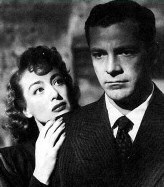 Andrews,
Dana. (1/1/09 - 12/17/92) Actor whose film and TV career spanned over
50 years, beginning in 1940. Co-starred with Joan in '47's Daisy Kenyon. He initially
agreed to the role, but tried to decline after reading the script. (His lawyer
advised him to stay on, so he did.) (JCB)
Andrews,
Dana. (1/1/09 - 12/17/92) Actor whose film and TV career spanned over
50 years, beginning in 1940. Co-starred with Joan in '47's Daisy Kenyon. He initially
agreed to the role, but tried to decline after reading the script. (His lawyer
advised him to stay on, so he did.) (JCB)
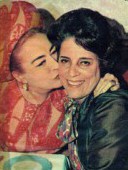 Angel,
Zuzu. (real name: Zuleika Angel Jones) (6/5/21 - 4/14/76) Brazilian designer
whom Joan met on a trip to that country for Pepsi in 1969. Joan subsequently
became a fan of her fashions, joining other American admirers such as Liza Minnelli
and Kim Novak. Angel was an activist against her country's dictatorship and
died in a suspicious car crash in '76.
Angel,
Zuzu. (real name: Zuleika Angel Jones) (6/5/21 - 4/14/76) Brazilian designer
whom Joan met on a trip to that country for Pepsi in 1969. Joan subsequently
became a fan of her fashions, joining other American admirers such as Liza Minnelli
and Kim Novak. Angel was an activist against her country's dictatorship and
died in a suspicious car crash in '76.
 Arden,
Eve. (4/30/12 - 11/12/90) Joan's snappy sidekick in 1945's Mildred Pierce and 1951's Goodbye My Fancy. She also made a brief appearance as
a rejected showgirl in the '33 Crawford-Gable vehicle Dancing Lady.
Arden was born "Eunice Quedens" and is perhaps best known for "Our
Miss Brooks," which was not only a radio show (CBS, 1948 - 1956), but also
a TV series (CBS, 1952 - 1956) and a movie (1956). (She is probably most remembered nowadays
as the principal of Rydell High in 1978's Grease.) IMDb
info.
Arden,
Eve. (4/30/12 - 11/12/90) Joan's snappy sidekick in 1945's Mildred Pierce and 1951's Goodbye My Fancy. She also made a brief appearance as
a rejected showgirl in the '33 Crawford-Gable vehicle Dancing Lady.
Arden was born "Eunice Quedens" and is perhaps best known for "Our
Miss Brooks," which was not only a radio show (CBS, 1948 - 1956), but also
a TV series (CBS, 1952 - 1956) and a movie (1956). (She is probably most remembered nowadays
as the principal of Rydell High in 1978's Grease.) IMDb
info.
Arden, Joan. This could've been the name we know Our Joan by today. See Artisdale, Mrs. Louise below regarding why she's now "Joan Crawford."
Ardmore, Jane Kesner. Co-writer of Joan's 1962 autobiography A Portrait of Joan. Said Joan in CWJC re the book: I'm a goddam image, not a person, and the poor girl who worked on it had to write about the image. It must have been terrible for her...I think she'd have been better off with Lassie... I must have driven the poor girl who worked on it crazy with the sins of omission. (A bright, darling woman, by the way.) But at the time it seemed right. Maybe it was right. I don't think I lied--I just left out a lot. There's a difference.
Arnold, Edward. Plays Joan's alcoholic sugar-daddy in 1934's Sadie McKee.
Arnold, Eve. (1912 - 2012) Photographer who covered Joan for photo-essays in Life magazine in 1956 and 1959, and also wrote about her in her 1995 book, In Retrospect (click link to read excerpt), and her 2001 Film Journal. In the former, she describes Joan in a rather unflattering light, including an anecdote about a drunken Joan insisting that Arnold photograph her in the nude. (And she also gets some of her facts wrong, saying, for one thing, that Joan "grew up as a prostitute in her mother's establishment," when by all accounts Joan's mother was a laundrywoman.)
Arnold, Johnny. (11/16/1889 - 1/11/1964) MGM cameraman who befriended Joan and gave her both acting and camera advice in her early days (telling her, for instance, that her face was "built" but that she just needed to lose some weight, which she promptly did). He worked on her films Sally, Irene, and Mary (1925), Paris (1928), Rose-Marie (1928), and Hollywood Revue of 1929, and was head of the MGM camera department from 1931 to 1956.
Arthur, George K. Appeared with Joan in Pretty Ladies (1925) and starred in The Boob (1926).
Artisdale, Mrs. Louise. Of 149 Dartmouth St., Rochester, New York. The winner of Movie Weekly's 1925 "Name Her and win $1,000" contest, which transformed "Lucille LeSueur" into "Joan Crawford." (The winning name was originally "Joan Arden," but since there were multiple submissions of this name, and thus the threat of MGM's having to pay multiple prize amounts according to US postal rules governing such contests, another entry was hastily agreed upon. A check for $500 was issued to Mrs. Artisdale on September 23, 1925.) Click here to read the initial 3/27/25 contest article from Movie Weekly which, among other oddities, says young Lucille was a debutante! (US)
 Arzner, Dorothy.
(1/3/1897 - 10/1/1979) One of the first female directors,
Arzner, an out Lesbian, began as a
typist at Paramount
Studios, graduating to continuity, then editing, then directing. She worked
at Paramount from '27 to '32, then freelanced, directing a total of 17 films (including
1929's The Wild Party with Clara Bow and '33's Christopher
Strong with Katharine Hepburn) before retiring from the industry in 1943.
During WWII, she directed WACs training films, then later taught at UCLA and
directed over 50 Pepsi commercials
at board-member Joan's request.
Arzner, Dorothy.
(1/3/1897 - 10/1/1979) One of the first female directors,
Arzner, an out Lesbian, began as a
typist at Paramount
Studios, graduating to continuity, then editing, then directing. She worked
at Paramount from '27 to '32, then freelanced, directing a total of 17 films (including
1929's The Wild Party with Clara Bow and '33's Christopher
Strong with Katharine Hepburn) before retiring from the industry in 1943.
During WWII, she directed WACs training films, then later taught at UCLA and
directed over 50 Pepsi commercials
at board-member Joan's request.
Arzner directed Joan's 1937 film The Bride Wore Red (and finished Joan's previous film The Last of Mrs. Cheyney after director Richard Boleslawski died during filming; she was uncredited). Joan's husband Franchot Tone initially recommended Arzner to Crawford after seeing her 1936 film Craig's Wife (later re-made as 1950's Harriet Craig, starring Joan). (Ultimate Star)
Wikipedia page. Agnesfilms.com interview. Columbia University page.
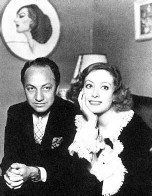 Asher, Jerry.
Joan got Asher a job in the MGM mail room, and he eventually advanced to the publicity
department, later becoming a fan magazine writer who churned out many favorable
Joan stories, and then a press agent. He was a Joan confidante and frequent guest at her home.(JCB)
And was also later very gossipy
about her personal life: See the Bisexuality
entry.
Asher, Jerry.
Joan got Asher a job in the MGM mail room, and he eventually advanced to the publicity
department, later becoming a fan magazine writer who churned out many favorable
Joan stories, and then a press agent. He was a Joan confidante and frequent guest at her home.(JCB)
And was also later very gossipy
about her personal life: See the Bisexuality
entry.
Ashley, Lady Sylvia. Had an affair with Doug Fairbanks, Sr., and married him (breaking up the famed Fairbanks-Pickford marriage), was widowed by him; then later married Clark Gable.
 Astaire, Fred.
(5/10/1899 - 6/22/1987) The iconic dancer made his film debut in Joan's 1933 film Dancing Lady,
performing two numbers with Joan: "The Gang's All Here" and "Let's
Go Bavarian." Joan was impressed with Astaire's marriage, and said in POJ:
Astaire, Fred.
(5/10/1899 - 6/22/1987) The iconic dancer made his film debut in Joan's 1933 film Dancing Lady,
performing two numbers with Joan: "The Gang's All Here" and "Let's
Go Bavarian." Joan was impressed with Astaire's marriage, and said in POJ:
Some men can't allow a woman to drive, but Fred didn't compete with his wife, he enjoyed her prowess...Fred, you see, is such a virile man, he's never had to prove it. In all his years in show business, I've never known him to be rude and never have seen him make a pass at a girl...He's kept himself intact, and he could because he's such a fulfilled man in his personal life...It was good for me to know that a marriage like theirs could happen in show business. I made a mental note.
 Asther, Nils. (1/17/1897
- 10/13/1981) Bisexual Swedish silent
star who appeared with Joan in
3 films: Our Dancing Daughters ('28), Dream of Love
('28), and Letty Lynton ('32). He was discovered in Sweden by Garbo's
mentor Mauritz Stiller and came to Hollywood in 1926, returning to his homeland
in the 1950s.
Asther, Nils. (1/17/1897
- 10/13/1981) Bisexual Swedish silent
star who appeared with Joan in
3 films: Our Dancing Daughters ('28), Dream of Love
('28), and Letty Lynton ('32). He was discovered in Sweden by Garbo's
mentor Mauritz Stiller and came to Hollywood in 1926, returning to his homeland
in the 1950s.
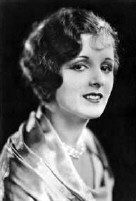 Astor, Mary.
(5/3/06 - 9/25/87) Actress, one of the 1926 crop of WAMPAS Baby Stars, which also included Joan.
Her career spanned an impressive 44 years,
from 1920 to 1964. (Her last film was Hush, Hush, Sweet Charlotte;
another notable film was '41's Maltese Falcon.) IMDb
info.
Astor, Mary.
(5/3/06 - 9/25/87) Actress, one of the 1926 crop of WAMPAS Baby Stars, which also included Joan.
Her career spanned an impressive 44 years,
from 1920 to 1964. (Her last film was Hush, Hush, Sweet Charlotte;
another notable film was '41's Maltese Falcon.) IMDb
info.
Auctions. See these individual entries for major Crawford auctions: Christie's (1993), Doyle (2011), and Plaza Art Galleries (1978). Each of the individual pages offers extra links to lists of items sold, etc. See also this site's Collectibles page for links to various items from the above and numerous other auctions.
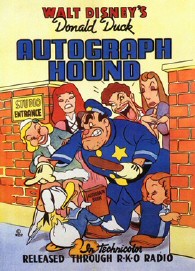
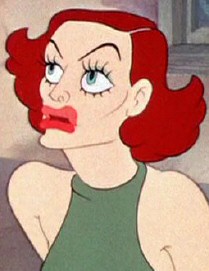 Autograph
Hound. 1939 RKO Disney cartoon featuring Donald Duck, who sneaks
into a studio trying to obtain celebrity autographs. Joan is one
of a couple of dozen cartoon celebrities that he encounters. Release
date: September 1, 1939. Time: 8:11. Directed by Jack King; written
by Harry Reeves.
Autograph
Hound. 1939 RKO Disney cartoon featuring Donald Duck, who sneaks
into a studio trying to obtain celebrity autographs. Joan is one
of a couple of dozen cartoon celebrities that he encounters. Release
date: September 1, 1939. Time: 8:11. Directed by Jack King; written
by Harry Reeves.
MovieswithMichael blogspot (featuring contemporary reviews and animation summary).
See also this site's ART page for original storyboard drawings of Joan plus larger final versions.
 Autumn
Leaves. Columbia, 1956. Directed by Robert Aldrich (who went on to direct Baby Jane), 108 minutes. Joan stars as "Millicent Wetherby,"
a lonely typist who falls in love with a disturbed younger man (Cliff Robertson). Says Joan in CWJC:
Autumn
Leaves. Columbia, 1956. Directed by Robert Aldrich (who went on to direct Baby Jane), 108 minutes. Joan stars as "Millicent Wetherby,"
a lonely typist who falls in love with a disturbed younger man (Cliff Robertson). Says Joan in CWJC:
One of my very favorite pictures...It was, I think, the best film of its type--the older woman with a younger lover--ever made. The loneliness and desperation of her situation came through with no need for melodrama or overacting--in fact, I played it down. Cliff Robertson was stunning; very few actors could have brought that kind of credibility to such a demanding part. His mad scenes can't be topped. (I'm proud to say I coached him from all the research I'd done for "Possessed.") Good story, believable characters, good script, good acting, consequently a good film...
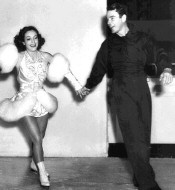 Ayres,
Lew. (12/28/08 - 12/30/96) Joan's co-star
in Ice Follies of 1939,
perhaps best known for his role as Dr. Kildare in the series of 1930s - 40s films.
In CWJC, Joan talks in her later years with regret about her lack of empathy
and uses Ayres as an example:
Ayres,
Lew. (12/28/08 - 12/30/96) Joan's co-star
in Ice Follies of 1939,
perhaps best known for his role as Dr. Kildare in the series of 1930s - 40s films.
In CWJC, Joan talks in her later years with regret about her lack of empathy
and uses Ayres as an example:
Someone very close to me said something absolutely devastating a few months ago...she recalled how furious I'd been because Lew Ayres was ten minutes late on the set one day when we were filming "Ice Follies" and I told him off... anyway, Lew is a beautiful and sensitive man, so easily hurt, and my friend said, a little bitterly, "Does it matter now that he was ten minutes late?"